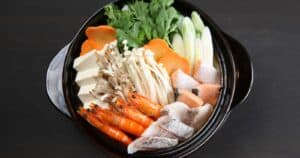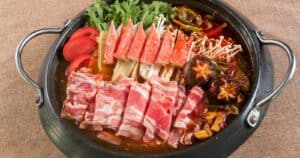The savory scent of simmering broth fills the air as your group gathers around a bubbling pot. Plates of thinly sliced meat, tofu, vegetables, and noodles stand at the ready. But as you begin cooking your ingredients in the pot, a question arises – is this Japanese hot pot or Korean?
With communal pots of broth at the center, hot pot dining experiences in Korea and Japan share some similarities. However, distinctions exist in broth flavors, meats, side dishes, and customs between the two versions. While hot pot originated in China centuries ago, Korea and Japan each put their own spin on the concept based on local tastes.
In Korea, hot pot often features a spicy, pungent kimchi-based broth and tender marinated meats like bulgogi. The Japanese style emphasizes lighter, subtler kombu and bonito broths with thin raw beef and pork. Yet no matter the particular ingredients, hot pot meals in both countries focus on gathering friends and family together for lively, interactive dining.
As you wait for the broth to reach a boil, get ready to cook up some memories with loved ones, no matter which side of the Japan/Korea hot pot debate you fall on! Now let’s dig into the rich cultural history behind this tasty traditional dish.
A Pot By Any Other Name
In Korean, hot pot goes by the name “jeongol” or “jjigae”, while the Japanese call it “nabemono”. Despite the different names, they operate on the same principle – a cooking pot of stock simmering at the table, into which diners add ingredients to cook and fish out when ready. The varieties differ depending on the broth, ingredients used and cooking methods.
Broth Basics
The foundation of any hot pot is the broth base. For Korean hot pot, the broth is generally anchovy-based, fiery and red in color. Popular flavors include kimchi, seafood and beef bone broth. The Japanese take is more subtle – clear, mild broths made from chicken, seaweed, miso or soy sauce seasoned dashi.
Korean hot pot broth is:
- Stronger flavored
- Spicier
- Red and opaque
Japanese hot pot broth is:
- Lighter tasting
- More subtle flavors
- Clear colored
This sets the stage for the types of ingredients used in each style.
Prime Proteins
When it comes to proteins, Korean hot pot goes big and bold. Thinly sliced beef like ribeye is popular, along with fatty pork belly and brined chicken. These stand up well to the intense Korean broth.
Japanese hot pot takes a lighter approach. You’ll often find thinly sliced Wagyu beef, seasonal seafood like prawns and fish, chicken and soft tofu. These delicately flavored ingredients suit the refined Japanese broth.
Korean hot pot meats:
- Marbled beef
- Pork belly
- Chicken
Japanese hot pot proteins:
- Wagyu beef
- Seasonal seafood
- Chicken
- Tofu
This shows how each cuisine plays to its strengths in the hot pot arena.
Veggie Variety
Korean hot pot utilizes hearty vegetables that complement the bolder broth. Common additions are mushrooms, kimchi, zucchini, cabbage, sweet potatoes and pumpkin. These stand up well to prolonged cooking times.
Japanese hot pot opts for more delicately flavored produce like negi onions, carrots, Chinese cabbage, enoki mushrooms and shiitake. They gently cook to perfection in the light broth.
Korean hot pot veggies:
- Mushrooms
- Kimchi
- Zucchini
- Cabbage
- Sweet potato
Japanese hot pot vegetables:
- Negi onions
- Carrots
- Chinese cabbage
- Enoki mushrooms
- Shiitake mushrooms
As you can see, the vegetables also follow the same pattern when it comes to full flavor versus subtle taste.
Noodle Know-How
A hot pot experience isn’t complete without noodles! Koreans add tender rice cakes, thick udon noodles and ram-don, which are instant noodles specifically designed for hot pot. These hearty noodles hold up in the intense broth.
In Japanese hot pot, you’ll find thinner somen noodles, chewy soba noodles and udon. The delicate strands pair nicely with the light seasoning of the soup.
Korean hot pot noodles:
- Rice cakes
- Thick udon noodles
- Ram-don instant noodles
- Somen noodles
- Soba noodles
- Udon noodles
Once again, this demonstrates the regional differences in hot pot philosophy.
Sauces and Seasonings
The sauces and seasonings are where you can really customize your hot pot experience.
For Korean jeongol or jjigae, popular dipping sauces are sesame oil with salt and pepper or a spicy gochujang-based sauce. These accentuate the bold flavors.
The Japanese take more of a subtle, clean approach. Common dipping sauces and garnishes are ponzu, sesame sauce, scallions and shichimi togarashi pepper.
Korean hot pot sauces:
- Sesame oil with salt and pepper
- Gochujang chili sauce
Japanese hot pot seasonings:
- Ponzu
- Sesame dipping sauce
- Scallions
- Shichimi togarashi
As you customize your hot pot with various sauces, you can tailor the flavor intensity to your personal tastes.
Cooking Methods
Both Korean and Japanese hot pot follow the same basic process – a simmering pot of broth as the stage, with raw ingredients added in stages to cook tableside. However, a few key cooking method differences affect the end result.
Korean hot pot comes to a rolling boil then simmers on high heat. The vigorous bubbling enhances the big flavors. It’s also customary to mix ingredients together in the pot and adjust seasoning to taste.
Japanese style values gentler treatment to protect delicate flavors. The broth maintains a gentle simmer with ingredients carefully lowered in separate batches to briefly cook. Seasoning is added individually at the table.
Korean hot pot cooking:
- Vigorous boiling
- Ingredients mixed in pot
- Broth seasoning adjusted tableside
Japanese hot pot cooking:
- Gentle simmer
- Ingredients batched by cooking time
- Seasoning added individually
As you can see, the cooking methods align to the overall dining philosophies.
The Verdict
While Korean and Japanese hot pot share origins from Chinese steamboat, they have evolved into distinct experiences showcasing regional ingredients and cooking techniques.
Korean hot pot is fiery, robust and highly seasoned. The bold broth stands up to fatty meats, hearty noodles and assertive spices. Gather a group and get ready for some unrestrained flavor!
Japanese hot pot focuses on delicate and refined. Subtle broth allows subtle ingredients to shine through. It’s light, clean and simple, perfect for highlighting pristine ingredients.
There’s no right or wrong – just different styles to suit different tastes! Trying both is the best way to become a hot pot connoisseur. With the right knowledge, you can now confidently join the hot pot trend heating up tables worldwide. Get your pots ready and cook up some cross-cultural bonding. Just be sure to leave room for seconds!





